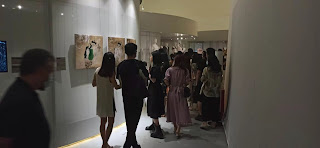The irony of Fashioned from Nature is that this is such a beautiful show about the destruction the fashion industry has wrought on the environment. This is not a comprehensive look at fashion from 1600 to the present, but, instead, the show uses samples of clothing from 1600 onward to look at how nature has been exploited and harmed to effect beauty, marketability and extravagance in our clothing. Indeed, an irony within the irony is that beautiful images from nature have often been design elements inherent in the production of clothing which harms nature.
It was the international trade networks established by the UK, and wealth generated from these networks, which allowed the Industrial Revolution to expand rapidly and the textile industry was a chief engine in the growth of factories, population and pollution of the air and water. The consumer economy developed in the UK (where cheap, mass-produced goods replaced hand-made production) magnified the waste and extravagance already involved in the production of clothing. Thus, the fashion industry has become one of our chief polluting industries, currently producing a massive amount of carbon emissions and consuming and contaminating vast amounts of our water.
The goal now in the fashion industry seems to be to try to go back to square one and begin producing longer-lasting clothing without the harmful waste of water and production of waste usually involved. And the show reveals how each major material in the production of clothing has presented problems. The dyeing of silk released massive waste pollutants into water supplies. To obtain flax fibers in order to produce linen, stalks had to be weakened through soaking, thus polluting sources of clean water. The processing of wool produced wastes that went into river systems. The bleaching of cotton caused the first acid rain. Cotton also exhausted, and continues to exhaust, water supplies as a “thirsty” crop. Hundreds of gallons of water go into the production of just one cotton dress shirt. The fashion industry has also contributed to the over-hunting of animals and there are examples concerning whales, beavers, wolves, seals, various types of birds, crocodiles, snakes, lizards and even beetles in the show.
The show does shift, ultimately, in a more optimistic mode as a number of recent innovations in the manufacturing of clothing are presented. We learn that more environmentally friendly clothing is now being produced by designers using longer lasting fibers like linen. Recycling has now also become a big trend as hundreds of thousands of tons of old clothing often go into world landfills. The current recycling trends not only involve old clothing but also the use of plastics. Production of flax only using ground water and rain is a method more ecologically friendly than cotton. Various well-established fashion companies are also lauded for producing cotton products using less water and leaving less of a carbon footprint. Yet, 1) free trade outsourcing using low-wage labor in countries with minimal environmental regulations, 2) new groups of consumers in developing countries and 3) the ease of e-commerce are still ensuring non-sustainable fashion production.
This review was also published in E The Environmental Magazine https://emagazine.com/review-fashioned-from-nature/
Thank you to both of those excellent platforms for carrying this review.
















No comments:
Post a Comment
Note: Only a member of this blog may post a comment.